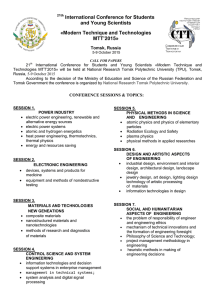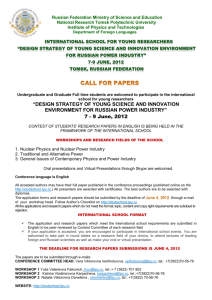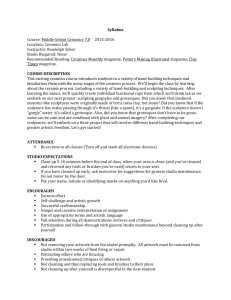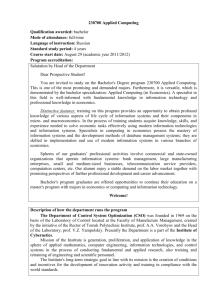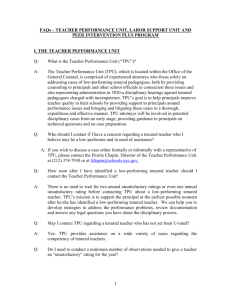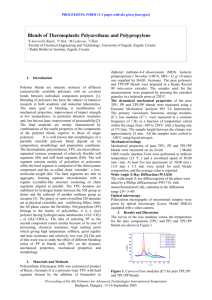pilot processing line of nano-center of tpu for manufacturing bulk
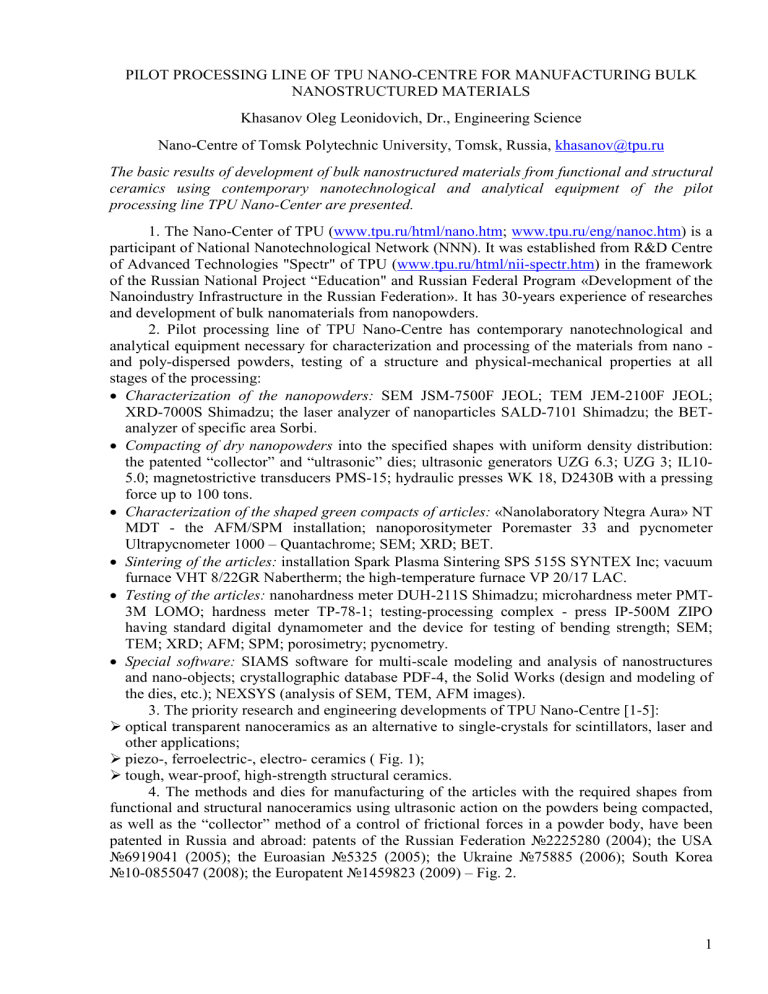
PILOT PROCESSING LINE OF TPU NANO-CENTRE FOR MANUFACTURING BULK
NANOSTRUCTURED MATERIALS
Khasanov Oleg Leonidovich, Dr., Engineering Science
Nano-Centre of Tomsk Polytechnic University, Tomsk, Russia, khasanov@tpu.ru
The basic results of development of bulk nanostructured materials from functional and structural ceramics using contemporary nanotechnological and analytical equipment of the pilot processing line TPU Nano-Center are presented.
1. The Nano-Center of TPU ( www.tpu.ru/html/nano.htm
; www.tpu.ru/eng/nanoc.htm
) is a participant of National Nanotechnological Network (NNN). It was established from R&D Centre of Advanced Technologies "Spectr" of TPU ( www.tpu.ru/html/nii-spectr.htm
) in the framework of the Russian National Project “Education" and Russian Federal Program «Development of the
Nanoindustry Infrastructure in the Russian Federation». It has 30-years experience of researches and development of bulk nanomaterials from nanopowders.
2. Pilot processing line of TPU Nano-Centre has contemporary nanotechnological and analytical equipment necessary for characterization and processing of the materials from nano - and poly-dispersed powders, testing of a structure and physical-mechanical properties at all stages of the processing:
Characterization of the nanopowders: SEM JSM-7500F JEOL; TEM JEM-2100F JEOL;
XRD-7000S Shimadzu; the laser analyzer of nanoparticles SALD-7101 Shimadzu; the BETanalyzer of specific area Sorbi.
Compacting of dry nanopowders into the specified shapes with uniform density distribution: the patented “collector” and “ultrasonic” dies; ultrasonic generators UZG 6.3; UZG 3; IL10-
5.0; magnetostrictive transducers PMS-15; hydraulic presses WK 18, D2430B with a pressing force up to 100 tons.
Characterization of the shaped green compacts of articles:
«Nanolaboratory Ntegra Aura» NT
MDT - the AFM/SPM installation; nanoporositymeter Poremaster 33 and pycnometer
Ultrapycnometer 1000 – Quantachrome; SEM; XRD; BET.
Sintering of the articles: installation Spark Plasma Sintering SPS 515S SYNTEX Inc; vacuum furnace VHT 8/22GR Nabertherm; the high-temperature furnace VP 20/17 LAC.
Testing of the articles: nanohardness meter DUH-211S Shimadzu; microhardness meter PMT-
3M LOMO; hardness meter TP-78-1; testing-processing complex - press IP-500M ZIPO having standard digital dynamometer and the device for testing of bending strength; SEM;
TEM; XRD; AFM; SPM; porosimetry; pycnometry.
Special software: SIAMS software for multi-scale modeling and analysis of nanostructures and nano-objects; crystallographic database PDF-4, the Solid Works (design and modeling of the dies, etc.); NEXSYS (analysis of SEM, TEM, AFM images).
3. The priority research and engineering developments of TPU Nano-Centre [1-5]:
optical transparent nanoceramics as an alternative to single-crystals for scintillators, laser and other applications;
piezo-, ferroelectric-, electro- ceramics ( Fig. 1);
tough, wear-proof, high-strength structural ceramics.
4. The methods and dies for manufacturing of the articles with the required shapes from functional and structural nanoceramics using ultrasonic action on the powders being compacted, as well as the “collector” method of a control of frictional forces in a powder body, have been patented in Russia and abroad: patents of the Russian Federation №2225280 (2004); the USA
№6919041 (2005); the Euroasian №5325 (2005); the Ukraine №75885 (2006); South Korea
№10-0855047 (2008); the Europatent №1459823 (2009) – Fig. 2.
1
Fig.1. Ceramics cases of microwave duplexers for cellular telecommunication systems
Fig.2. Types of ceramics articles for which manufacturing the collector dies have been developed
5. International cooperation:
The CRDF Grants: Russian-American Technology Showcase (IBM Venture Capital, Menlo
Park - “Silicon Valley”, CA, 2002); the joint project with the Norfolk State University (VA,
2005-2006)
The SABIT Grant: Training Program in Technology Commercialization (2002)
The FP-7 Proposals (have not been supported): KERAMIK-UNION (NMP-2008-2.1-2; 2008);
CERTOOL (FP7-NMP-2009-SME-3; 2009)
University of Orleans (France): three Scientific Workshops «Nanotechnology, energy, plasma, lasers (NEPL) have been organized:
•
2007 – Bourges (France); supported by the Russian Foundation for Basic Research
(RFBR), Orleans University and Bourges;
•
2008 – Tomsk; supported by the RFBR, University of Orleans;
•
2009 – Toulouse; supported by the RFBR, CNRS.
Institute of Science and Technology of Ceramics (Faenza, Italy)
2
•
2008 – the Project in FP-7
•
The invited paper at the 2 nd
International Congress on Ceramics (ICC-2), Italy ( Global
Roadmap for Ceramics )
Universite Joseph Fourier (UJF, Grenoble, France)
•
2009 - UJF, the Bangalore Research Centre (India) and TPU Nano-Centre have organized two on-line Internet Video-conferences «Intensive courses of lectures» of the professors and leading experts of UJF and TPU in the framework of UJF Master Program «Master in
Nanosciences, Nanotechnologies» (Master N
2
).
Universität Karlsruhe – Karlsruhe Institute of Technology (Germany):
•
2005-2008: four Russian-German Workshops on ecological aspects of the nanomaterials
“KarlsTom” have been organized.
University of Kassel (Germany): the joint project «Innovative Russian-German cooperation in the nanotechnologies” was submitted to BMBF.
Hermsdorf Institute for Technical Ceramics (HITK) - Fraunhofer-Institut für Keramische
Technologien und Systeme – IKTS (Germany): the joint development of nanoceramics technology.
International Science & Technology Center (ISTC): Project #3719 “Formation of grain boundaries in optical nanoceramics” (2007-2010); collaborator - Jenoptik AG (Jena,
Germany)
TEMPUS IV - NaNoRu Proposal (2010).
Conclusions:
1. In globalization it is mutually advantageous to find the ways for application of scientific potential of Russian researchers at development of the new technologies in cooperation with foreign partners from science and business on the basis of existing mechanisms for transfer of intellectual property rights (license agreements; joint patenting, etc.).
2. Experience of the compatriots working abroad in various formats, e.g. «representation of interests of Tomsk region; the informational assistance, the marketing help»
( http://obzor.tomsk.ru
; 02.04.2010), application of "infrastructural know-how» (features for presentation of the projects taking into account the systems of granting funds, the international and regional programs, etc.) are invaluable to minimize shortcoming of "trial and error method" at determination of cooperation relations.
1. O.L.Khasanov, V.M. Sokolov, E.S. Dvilis, Yu.P.Pokholkov. Ultrasonic technology for production of structural and functional nanoceramics//Adv. Materials.- 2002. - № 1. P. 76 – 83.
2. O.L. Khasanov, E.S. Dvilis, V.M. Sokolov. Compressibility of the structural and functional ceramic nanopowders. – J.Eur.Cer.Soc.- 2007.- V.
27. No.2-3.- P.749-752.
3. O.L. Khasanov, E.S. Dvilis. Net-shaping nanopowders with powerful ultrasonic action and methods of the density distribution control // Adv.Appl.Cer.- 2008.- V.
107 .- No.3.- P.135-
141.
4. Khasanov O., Dvilis E., Sokolov V. and Pokholkov Yu. Mechanisms of dry powder netshaping under ultrasonic vibration and by the collector method // In: Global Roadmap for
Ceramics. Proc. 2 nd
Int. Congress on Ceramics ICC-2.- 2008.- ISTEC, Italy.- P.359-368.
5. V.V.Osipov , O.L.Khasanov, V.A.Shitov, E.S.Dvilis, et al. Optical Nd 3+ Y
2
O
3
Ceramics of Nanopowders Compacted by Static Pressure Using the Ultrasonic Method //
Nanotechnologies in Russia.- 2008.- V.3.- Nos.7–8.- P. 474–480.
3

